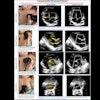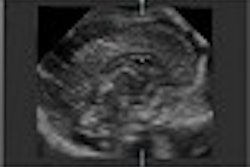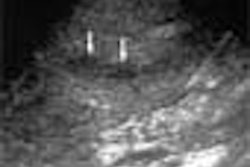Ultrasound has assumed an important role in breast imaging, as an adjunct to diagnostic mammography for biopsy guidance, dense-breast imaging, and the characterization of suspicious lesions. But the technology has some drawbacks when used for this application, including a lack of quantitative accuracy, global spatial resolution, and operator independence.
A Salt Lake City company is hoping to change that by developing an ultrasound-based system optimized for breast imaging. The company, TechniScan (TSI), considers its SafeScan product to be an ultrasound version of CT scanning that could revolutionize medical imaging just as CT did more than 20 years ago.
The company believes that mammography will continue to be the primary means of identifying small calcifications that correlate with certain types of cancer. But it also believes that, since ultrasound can enhance mammography’s diagnostic accuracy, ultrasound will become more and more useful as a secondary diagnostic modality to mammography. Eventually, ultrasound could replace mammography for the 15% to 30% of women with dense breasts, as well as women with implants, according to company executives.
TechniScan is one of the first companies to design an ultrasound system specifically for breast imaging, according to David Robinson, CEO. "In SafeScan, we’re creating a specific, single-purpose ultrasound device for breast imaging, rather than using ultrasound as it is to image the breast," Robinson said.
Established in 1984 by chief scientist and chairman Steven Johnson to conduct basic research for the U.S. government, TechniScan has long developed ultrasound and reflection-tomography imaging technology used in remote sensing equipment for such applications as identifying underground buried waste or oil spills. But its main R&D efforts have been focused on using this technology for the early detection and diagnosis of breast cancer.
The technology’s feasibility and theoretical validity was demonstrated in the mid-1980s, according to Robinson, but the speed of algorithms and computers at the time limited its use until 1999, when TechniScan scientists made a series of mathematical breakthroughs that led to the technology's being used in breast imaging. In 2000, TechniScan received a $750,000 grant from the National Cancer Institute to develop the system.
SafeScan produces color 3-D images using proprietary TScan software developed by TSI. The unit consists of a table on which a woman lies prone with the target breast hanging into a water-bath array with 768 sensors on each side. The sensors both rotate and move up and down to collect data. Each scan takes 20 to 30 seconds per slice of data, and 40 to 50 slices comprise a full exam.
SafeScan’s computer generates 1 GB of data per second, which is downloaded into a miniature supercomputer that produces the 3-D images. Images are displayed on a workstation, where they can be viewed and modified, and either printed or digitally archived.
The system’s software generates images using three kinds of ultrasound technology: reflection tomography (which generates cross-sectional slices like an MRI exam), inverse scattering of the speed of sound, and inverse scattering of acoustic absorption. In addition to these techniques, SafeScan uses artificial intelligence software to integrate data such as previous mammography exams, a woman’s age and family history, and the texture and characteristics of the lesion itself.
"SafeScan’s reflection tomography technology offers uniform spatial resolution of about 0.5 mm through the entire data slice, whereas in regular ultrasound that resolution falls off inversely with distance," Johnson said. "Our inverse-scattering technique produces images that are completely corrected for multiple scattering, reverberation, refraction, and absorption."
It’s the inverse scattering that sets SafeScan apart from other ultrasound breast imaging techniques. "Inverse scattering allows us to accurately recreate real tissue for speed of sound and attenuation of sound," Robinson said. "The beauty of this is that it allows us to produce a 3-D image that is accurately registered in all spatial directions."
One problem with using conventional ultrasound for breast imaging is that results vary according to the skill of the operator. But TechniScan believes that SafeScan’s design, combined with its inverse scattering technique, avoids this problem, therefore minimizing interruptions to radiologists and increasing patient throughput. In addition, TechniScan expects that SafeScan will reduce the number of unnecessary biopsies because clinicians will get more specific information about what they’re imaging.
The company is interested in a partnership with a large OEM to bring its technology to market, Robinson said. TechniScan has hired a consulting firm to help it apply for 510(k) clearance from the Food and Drug Administration for the SafeScan system as a single-use ultrasound unit, and plans to begin the process this year.
The company also plans to submit a premarket approval (PMA) application that will allow it to make claims about SafeScan’s diagnostic capabilities for breast imaging. Target sales price for the device will be under $300,000. TechniScan will exhibit its SafeScan system publicly for the first time at the 2002 RSNA meeting.
By Kate Madden Yee
AuntMinnie.com contributing writer
February 13, 2002
Related Reading
Ultrasound has unique strengths in breast imaging, January 22, 2002
MRI beats US, mammo for tracking breast tumor response, January 7, 2002
Ultrasound aids mammography in breast cancer diagnosis, December 3, 2001
New ultrasonic approach focuses on breast imaging, November 27, 2001
Copyright © 2002 AuntMinnie.com




















